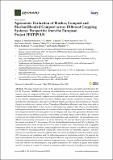Por favor, use este identificador para citar o enlazar a este item:
http://hdl.handle.net/10261/182932COMPARTIR / EXPORTAR:
 SHARE SHARE
 CORE
BASE CORE
BASE
|
|
| Visualizar otros formatos: MARC | Dublin Core | RDF | ORE | MODS | METS | DIDL | DATACITE | |

| Título: | Agronomic evaluation of biochar, compost and biochar-blended compost across different cropping systems: perspective from the european project FERTIPLUS |
Autor: | Sánchez-Monedero, Miguel Ángel CSIC ORCID ; Cayuela, María Luz CSIC ORCID ; Sánchez-García, María CSIC ; Vandecasteele, Bart; D’Hose, Tommy; López, Guadalupe; Martínez-Gaitán, Carolina; Kuikman, Peter J.; Sinicco, T.; Mondini, Claudio | Palabras clave: | Fertilization Nutrient recycling Organic waste management Pyrolysis Composting Soil organic matter Soil fertility Crop yield |
Fecha de publicación: | 4-may-2019 | Editor: | Multidisciplinary Digital Publishing Institute | Citación: | Agronomy 9(5): 225 (2019) | Resumen: | This paper reports the results on the agronomic performance of organic amendments in the EU 7th FP project “FERTIPLUS—reducing mineral fertilizers and agro-chemicals by recycling treated organic waste as compost and bio-char”. Four case studies on field-scale application of biochar, compost and biochar-blended compost were established and studied for three consecutive years in four distinct cropping systems and under different agro-climatic conditions in Europe. These included the following sites: olive groves in Murcia (Spain), greenhouse grown tomatoes in Almeria (Spain), an arable crop rotation in Oost-Vlaanderen (Merelbeke, Belgium), and three vineyards in Friuli Venezia Giulia (Italy). A slow pyrolysis oak biochar was applied, either alone or in combination with organic residues: compost from olive wastes in Murcia (Spain), sheep manure in Almeria (Spain), and compost from biowaste and green waste in Belgium and Italy. The agronomical benefits were evaluated based on different aspects of soil fertility (soil total organic carbon (TOC), pH, nutrient cycling and microbial activity) and crop nutritional status and productivity. All amendments were effective in increasing soil organic C in all the field trials. On average, the increase with respect to the control was about 11% for compost, 20% for biochar-blended compost, and 36% for biochar. The amendments also raised the pH by 0.15–0.50 units in acidic soils. Only biochar had a negligible fertilization effect. On the contrary, compost and biochar-blended compost were effective in enhancing soil fertility by increasing nutrient cycling (25% mean increase in extractable organic C and 44% increase in extractable N), element availability (26% increase in available K), and soil microbial activity (26% increase in soil respiration and 2–4 fold enhancement of denitrifying activity). In general, the tested amendments did not show any negative effect on crop yield and quality. Furthermore, in vineyards and greenhouse grown tomatoes cropping systems, compost and biochar-blended compost were also effective in enhancing key crop quality parameters (9% increase in grape must acidity and 16% increase in weight, 9% increase in diameter and 8% increase in hardness of tomato fruits) important for the quality and marketability of the crops. The overall results of the project suggest that the application of a mixture of biochar and compost can benefit crops. Therefore, biochar-blended compost can support and maintain soil fertility. | Descripción: | © The Author(s). | Versión del editor: | https://doi.org/10.3390/agronomy9050225 | URI: | http://hdl.handle.net/10261/182932 | DOI: | 10.3390/agronomy9050225 | E-ISSN: | 2073-4395 |
| Aparece en las colecciones: | (CEBAS) Artículos |
Ficheros en este ítem:
| Fichero | Descripción | Tamaño | Formato | |
|---|---|---|---|---|
| Agronomic_Sanchez_Monedero_Art2019.pdf | 8,54 MB | Adobe PDF |  Visualizar/Abrir |
CORE Recommender
SCOPUSTM
Citations
76
checked on 30-mar-2024
WEB OF SCIENCETM
Citations
63
checked on 24-feb-2024
Page view(s)
322
checked on 22-abr-2024
Download(s)
299
checked on 22-abr-2024
Google ScholarTM
Check
Altmetric
Altmetric
Este item está licenciado bajo una Licencia Creative Commons

